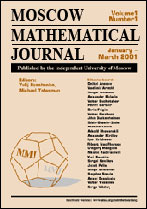|
This article is cited in 5 scientific papers (total in 5 papers)
Newton polytopes for horospherical spaces
Kiumars Kaveha, A. G. Khovanskiibcd
a Department of Mathematics, University of Pittsburgh, Pittsburgh, PA, USA
b Institute for Systems Analysis, Russian Academy of Sciences
c Independent University of Moscow
d Department of Mathematics, University of Toronto, Toronto, Canada
Abstract:
A subgroup $H$ of a reductive group $G$ is horospherical if it contains a maximal unipotent subgroup. We describe the Grothendieck semigroup of invariant subspaces of regular functions on $G/H$ as a semigroup of convex polytopes. From this we obtain a formula for the number of solutions of a system of equations $f_1(x)=\dots=f_n(x)=0$ on $G/H$, where $n=\dim(G/H)$ and each $f_i$ is a generic element from an invariant subspace $L_i$ of regular functions on $G/H$. The answer is in terms of the mixed volume of polytopes associated to the $L_i$. This generalizes the Bernstein–Kushnirenko theorem from toric geometry. We also obtain similar results for the intersection numbers of invariant linear systems on $G/H$.
Key words and phrases:
reductive group, moment polytope, Newton polytope, horospherical variety, Bernstein–Kushnirenko theorem, Grothendieck group.
Received: July 14, 2010; in revised form October 18, 2010
Citation:
Kiumars Kaveh, A. G. Khovanskii, “Newton polytopes for horospherical spaces”, Mosc. Math. J., 11:2 (2011), 265–283
Linking options:
https://www.mathnet.ru/eng/mmj421 https://www.mathnet.ru/eng/mmj/v11/i2/p265
|

|




 Contact us:
Contact us: Terms of Use
Terms of Use
 Registration to the website
Registration to the website Logotypes
Logotypes








 Citation in format
Citation in format 
